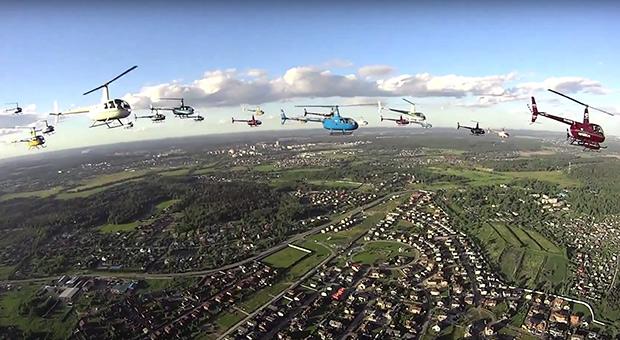Formation Flying Tips for Helicopter Pilots: Communication, Coordination, and Safety

Tips for successful flying in the company of helicopters
Formation flying can be an exhilarating and efficient way to travel with fellow helicopter pilots. However, it requires planning and coordination to ensure safety and effectiveness. Here are some Helipaddy community tips for successful formation flying.
Communication is Key

- Use a “Company” Frequency: When flying along, it is beneficial to use a frequency familiar to all members of the group. Typically, the frequency of the group’s home airfield is a good choice when abroad. This frequency is usually pre-programmed for everyone and is unlikely to be active when far from home, unlike 123.45 which is often over-shared.
- Airfield Frequency for Manoeuvring: At smaller airfields, also consider using the airfield frequency even if everyone has two radios. Agree on a shortcode for aircraft identification, such as the last letter of your call sign or the first letter of the pilot’s name, whatever is unique and memorable. Although you have to keep transmissions short and sharp, this method can be effective when trying to lift in the right order.
- Formation Radio Operator: Designate one aircraft with two radios as the formation radio operator each leg. This pilot will handle all communications, streamlining the process and avoiding confusion.
Coordination with Air Traffic Services (ATS)
- Squawk Management: When receiving a basic service as a formation, ATS usually requests only the lead helicopter to squawk while others use standby. However, this will cause aircraft to disappear from ADSB traffic displays. If your helicopters are equipped with glass cockpits, it may be better to decline this request to maintain visibility of others.
- Landing in Formation: To avoid over-occupying the circuit, bunch together well in advance of the airfield. This ensures a smooth and coordinated landing process.
- Fuel Stops: Be prepared for extended waiting at fuel stops if refuelling together. At smaller airfields, it can be more efficient to separate during a long leg and refuel as each helicopter arrives. For busier airports, staying in formation might be preferable to avoid overwhelming controllers with multiple arrivals.
Practical Tips for Smooth Operations

- Bringing a Set of Wheels: Consider bringing a set of wheels for faster, more efficient group refuelling. This can significantly reduce downtime and keep the formation on schedule.
- Departure Coordination: When departing from larger airports, try to depart as a formation. This prevents being split up by commercial flights and avoids long waits on the taxiway.
Safety Measures for Specific Scenarios

- Sea Crossings: For long sea crossings, the helicopter carrying the life raft should fly at the back. One of the other helicopters should enter a hold pattern nearby the ditched one, acting as a rescue coordinator and maintaining good contact on 121.5. This aircraft can climb if necessary to get good radio contact with rescue.
- Approaching Private Sites: When approaching a private site, spacing a few miles between helicopters can be beneficial. A deconfliction strategy is critical if remaining in formation as the lead aircraft needs time to assess the landing site and report back. Agree a precise pressure setting for the group, making sure everyone has their altimeters set the same, so that vertical separation can be organised. If holding is necessary, agree on a 1-minute right-hand circuit around the prospective site maintaining at least 1000 feet.
Position Reporting
- Distance Over Time: When comparing positions, always report “distance to run” rather than “ETA.” Providing distance-based figures ensures that your position in space is clear to all formation members.
- Don’t overspeed: When trying to hold a formation speed, adopt the airspeed of the slowest pilot. It is surprising how the speed can gradually build in a formation.
Performance
- Engine performance: It’s fun to compare aircraft performance, especially when flying identical types with similar loads. It can be pretty eye-opening to find your engine is working 10% harder than the one flying along side you! Keep a note of fuel state at the start of the trip (probably “full”).
- Fuel burn: Every time you fill back up to full, make a mental note of the hours difference and divide the litres added by the hours flown. Observe how your hourly consumption compares.
Formation flying demands precision, clear communication, and mutual understanding among pilots. By following these tips, you can ensure a successful and enjoyable Helisafari!
Happy flying from the Helipaddy team!


